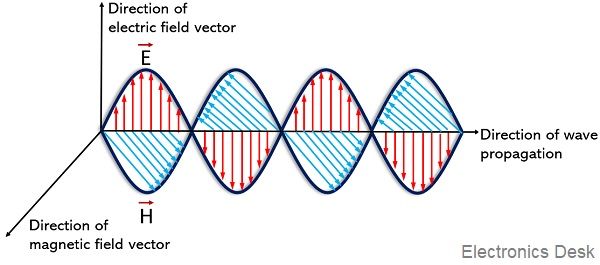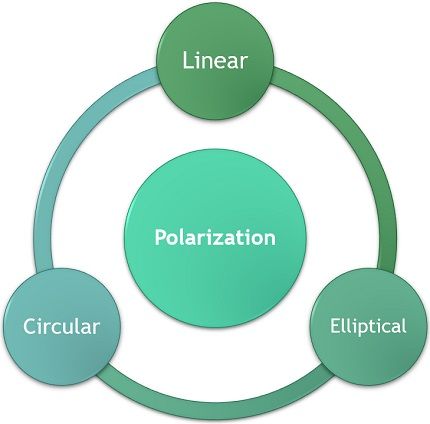Definition: Antenna Polarization is the term used in correspondence with the electromagnetic wave radiated through it. It is defined as the orientation of the electric field vector of the radiated electromagnetic wave by the antenna with a negligible amount of losses.
Polarization of the antenna is regarded as a crucial parameter and must be considered at the time of choosing or installing the antenna. It is simply related to the characteristics of wave polarization.
Content: Antenna Polarization
- Introduction
- What is Polarization?
- Polarization of Antenna
- Types
- Co-Polarization and Cross-Polarization
Introduction
We know that antennas are transducers that change one form of energy into another. It is a device that allows free-space propagation of wave by converting the electrical signal into electromagnetic waves.
As the antenna is associated with the transmission and reception of waves thus, the orientation of the wave while propagation describes the polarization of the antenna.
Antenna polarization is mainly specified along the main beam as the characteristics are usually constant along the main beam. However, there exists a difference in the polarization of the radiation from the side lobes than the main beam. Thus, if the direction of polarization is not given then the direction from where the maximum gain is achieved is taken into consideration.
What is Polarization?
Before having a detailed discussion on the polarization of the antenna we must be completely aware of the term polarization.
So, basically polarization is defined as the special property of electromagnetic waves that provides a specific relation between the time-varying direction and magnitude of the vibrating electric field. More simply, it can be said that polarization represents how the electromagnetic waves are physically oriented in space.
We all know that in the case of transverse electromagnetic waves there is an electric field vector associated that vibrates in the direction perpendicular to the direction of wave propagation.
In the case of unpolarized electromagnetic waves, the waves vibrate in the same direction and the electric field are randomly oriented about the propagation axis.
The electromagnetic waves possess linear polarization when their alignment in space is the same.
Polarization of Antenna
The polarization of the antenna is associated with the wave which is radiated or received by that antenna in a given direction. However, in the case of unspecified direction, the antenna polarization is considered along the direction where the gain is maximum.
Another noteworthy point over here is that the antenna polarization changes with the change in distance from the centre of the antenna. Thus, the various antenna parts may have different polarization.
We know an electromagnetic wave has both electric and magnetic field component. The electric and magnetic vector are mutually perpendicular to the direction of wave propagation.
But polarization is always explained in reference to the electric vector. Due to this reason; we define the plane of polarization of the radio waves in the direction of the electric vector.
The figure below shows the representation of electromagnetic waves in free space with electric and magnetic field component:
It is to be noted here that the direction of the antenna and its polarization is similar. Due to this reason, a vertical antenna radiates vertically polarized waves, while horizontal antenna radiates horizontally polarized waves.
This can be understood from the figure shown above. Here we can clearly see that the electric field vector is vertical thus the waves are vertically polarized. This means if the electric field vector is present in the vertical plane above the surface of the earth then it is known as vertically polarized.
Likewise, when the electric field vector is along the horizontal plane then it is called horizontally polarized waves.
Hence polarization is the characteristical property of the antenna designed to radiate linearly polarized wave.
So, after the above discussion, we can say that the physical orientation of the antenna in space gives the basic idea about the polarization of the waves. This signifies that type of polarization is the designing factor of the antenna. Let us now see the various classification of antenna polarization.
Types of Antenna Polarization
On a general basis, antenna polarization is classified as:
- Linear Polarization: A type of polarization in which all the waves possess similar alignment in space either vertical or horizontal is known as linear polarization. We have already discussed the vertically and horizontally polarized electromagnetic waves in the previous section. Both these types of polarizations are regarded as linear polarization.
An antenna that either radiates vertically polarized or horizontally polarized waves is known as a linearly polarized antenna. This type of polarization is mainly used by the antenna that is employed in space wave propagation.
- Circular Polarization: Antennas that are designed to radiate horizontally, vertically along with all planes in between are called circularly polarized antenna.
Now the question arises how circularly polarized waves are produced?
So, when two linearly polarized waves specifically of equal amplitudes are produced by a single antenna in the same direction in mutually perpendicular orientation w.r.t each other, then circularly polarized waves are produced. This means the two linearly polarized waves must possess a phase difference of 90°.
Also, according to the rotational format, the circular polarization may be right or left-handed. This depends on the polarity of the phase difference.
Circular polarization suits VHF, UHF and microwave applications. For example: in radar applications for reducing clutter echoes, in artificial satellites, etc.
Maximum efficiency between transmitting and receiving antennas are obtained when both the antennas exhibit circular polarization.
- Elliptical Polarization: Elliptically polarized waves are again generated from the two linearly polarized waves like the circularly polarized waves. We have recently discussed in circularly polarized waves that the amplitude of the two linearly polarized waves must be specifically equal.
But when two linearly polarized waves of unequal amplitudes that are mutually perpendicular to each other are combined then the elliptically polarized wave is produced.
It is to be noted here that the Axial Ratio plays a crucial role in determining the type of polarization. It is the ratio of the field in a vertical plane to the field in a horizontal plane. It is abbreviated as AR and generally, its value lies between 1 to ∞.
For circularly polarized antenna it lies between 0 to 2. However, for value more than 2, polarization is regarded as elliptical and it is infinite for linear polarization.
Co-Polarization and Cross-Polarization
Sometimes polarization may also be categorized as co-polarization and cross-polarization.
Generally, some undesired radiations are also emitted from the linearly polarized antenna and these are termed as cross-polarization and their direction is normal to the direction of the actual radiation.
However, co-polarization is the polarization that is in the direction of the plane of radiation.
Thank you electronics desk, this is a wonderful website all the concepts are available here in a simple and concise manner.